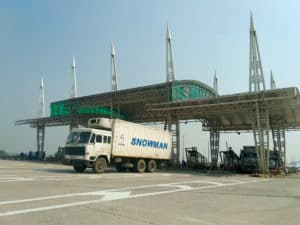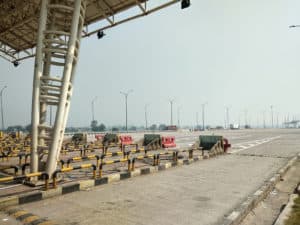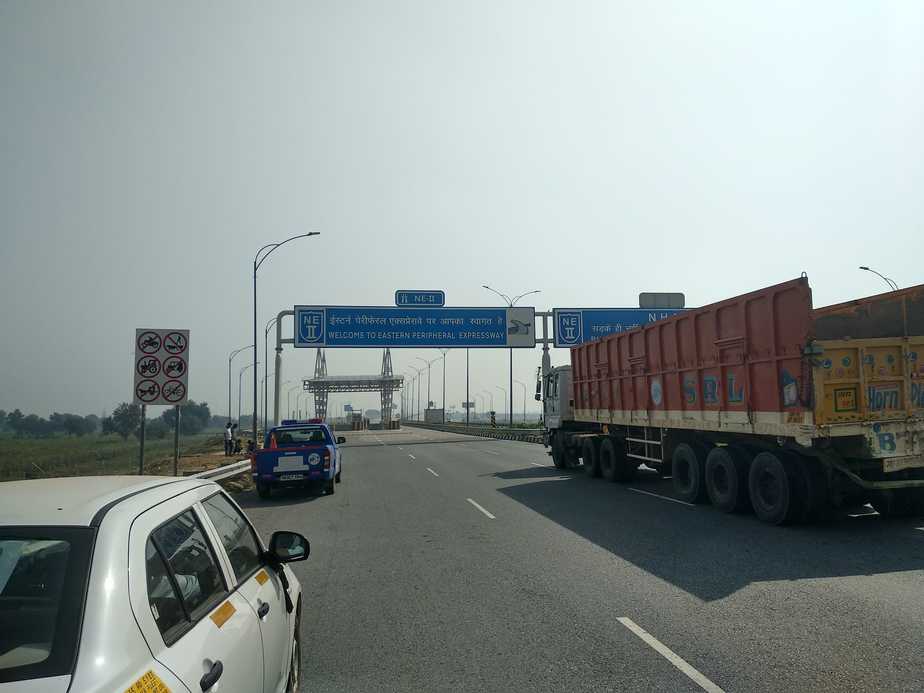Whereas trucks are now bypassing Delhi due to the Eastern Peripheral Expressway, thermal power plants continue to pollute its air, with one measure cancelling out the other
“If we were standing on the older route, I would’ve been driving right now and not sleeping in my truck,” says S Mahalingam, a 30-year-old truck driver who thinks the new Eastern Peripheral Expressway is a boon.
Mahalingam, who has driven throughout India on work, finds that with each passing year, his life as a truck driver is becoming easier, because of the new highways that come up every successive year.
Earlier, each time Mahalignham entered Delhi, he had to pay almost Rs 3,800 as toll charges, and Rs 200-300 if a traffic cop stopped him for a bribe to let him reach his destination. Ever since the new expressway was built, the cost has come down to Rs 725 for each trip he makes.
The six-lane Eastern Peripheral Expressway, built at a cost of Rs 11, 000 crore, was inaugurated on May 27. It starts from Kundli, goes via Ghaziabad and ends at Palwal – and is already becoming a lifeline for the truck drivers Patriot spoke to.

The city of Delhi has gained tremendously, as traffic congestion decreases and so does severe pollution hazard. According to figures provided by the supervisor at the toll plaza in Palwal, about 4,500 trucks use the highway every day, roughly bringing the monthly figure to 1,35,000 trucks. This is the number of truck entering Delhi through the eastern border.
“We are collecting almost Rs 35 lakh from the toll plaza every day,” says the supervisor at the Palwal toll plaza of Eastern Peripheral Expressway.
“More and more truck drivers will use the highway because it’s fast and saves a lot of time,” says Bhure Lal, Chairman, Environment Pollution (Prevention and Control) Authority (EPCA). He says that the immediate change in the pollution level and the contribution of the expressway towards this “is yet to be seen.”
According to Lal, the Western Peripheral Expressway which is the slated for inauguration in November this year, will have RFID (Radio Frequency Identification Devices). These RFIDs will let trucks pass through the toll plaza without stopping for the usual time. “That will also make that area less polluted,” says Lal.
So far so good. However, many reports have surfaced this week, that the air quality index, which measures the concentration of poisonous particulate matter, has hit 331 in parts of Delhi; anything over 100 is considered unhealthy by the Central Pollution Control Board. So while the expressway may have contributed to cleaner air for Delhi, there are other areas of concern.
Although the authorities usually put the blame on burning of crops in Punjab and Haryana, Sunil Dahiya of the Indian branch of the global environmental group Greenpeace, says there are five other things which pollute Delhi on a daily basis.
“Transportation, small- and large-scale industries, power plant, construction and waste contribute too for making Delhi one of the most polluted cities in the world,” says Dahiya.

“The power plants which are running around a 100-km radius of Delhi also contribute largely to the pollution,” he adds. He says that the government should put more focus on solar energy, as the production and logistics cost of coal are far greater than it is to generate power from solar energy plants.
“You can get the same power at the rate of Rs 2.5 per unit, instead of paying Rs 4.5,” added Dahiya.
A 2018 report done by Louisiana State University with contributions from Greenpeace, puts the spotlight on thermal power plants and suggests cutting down the usage of solid fuel in households. The report says that if we adopt certain measures, air pollution levels can be brought down by 40 per cent and also avoid 9 lakh premature deaths which take place due to air pollution.
With over 1 lakh vehicular population, a 2016 report done by IIT Kanpur estimates that in terms of PM emission, petrol cars contribute about 22% and the remaining 78% is contributed by diesel cars; whereas contribution of CNG cars is negligible.
It also threw light on a new technology that deserves immediate attention: retro-fitment of Diesel Particulate Filter (DPF); these filters have PM emission reduction efficiency of 60-90%. If a diesel vehicle entering the city has been equipped with DPF, there is a reduction of 40% emission. This reduction in emission will reduce the ambient air concentration by 10 ug/m3.
For instance, at the toll plaza, the truck driven by Ajit from Rajasthan was throwing out more emission than the other three trucks lined right after each other. “It’s a very old truck. It requires a visit to the service centre. I can only get it done when the truck is free,” says Ajit. He usually travels from Guwahati to Kochi and goes via the NCR region if there is a delivery to be done.
“We never want to go to Delhi anyway. The traffic is too much. Truck drivers feel more frustrated than car owners,” addes Ajit.
With the increasing level of pollution in the capital, Dahiya of Greenpeace also throws light on the Khurja super thermal power plant, which is slated to generate 1,320 megawatt power. The problem, according to Dahiya, is “It’s only 70 km from Delhi.” He says that the area where the plant is coming into place is already a highly polluted area. He also says that it is relatively easy to put regulations over power plants, Badarpur Power Plant being one such example.
However, the government has already put a deadline of December 2019 for retrofitting new technology in older power plants to reduce the emission levels. Dahiya says, “Introducing new power plants will only put more load on the pollution level in the capital, even if they adapt to the new technology.”
In Delhi’s delicate ecology, it does seem that what one hand takes away, the other puts back.





